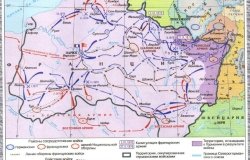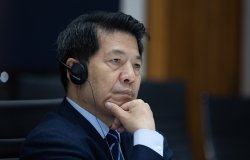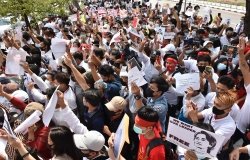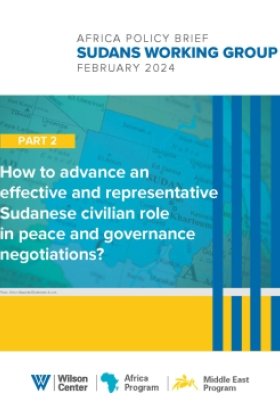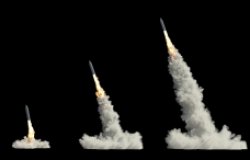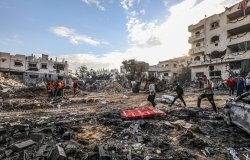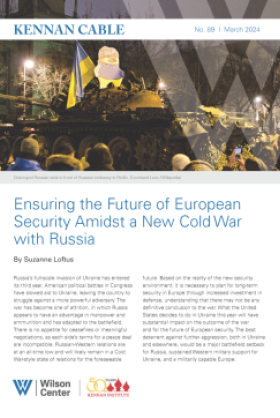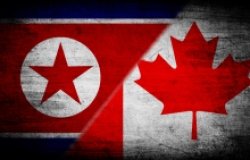Interpreting Iran’s Mixed Messages
"These mixed messages suggest that the Iranian leadership is either split over relations with the United States and the handling of the ISIS crisis in Syria and Iraq, or that it hasn't decided exactly which positions to adopt at a time of rapid and unpredictable change," writes Haleh Esfandiari.
Iranian President Hassan Rouhani and his foreign minister, Mohammad Javad Zarif, have been busy explaining their country’s policies in media interviews and meetings scheduled around the U.N. General Assembly opening. Their message has been mixed.
On the one hand, they seem to be hewing to the hard line laid down by Iran’s supreme leader, Ayatollah Ali Khamenei, on the country’s nuclear program, relations with the U.S., and the problem of ISIS militants in Syria and Iraq. On the other hand, the two officials, particularly President Rouhani, have sounded notes of moderation and readiness for accommodation.
Consider: In remarks to media after his recent prostate surgery Ayatollah Khamenei described himself as “amused” by official U.S. comments on ISIS in Iraq and Syria. He dismissed the anti-ISIS coalition the U.S. has assembled as “hollow”; alleged that Washington wished to do in Iraq and Syria what it is doing in Pakistan (“bombing wherever they want”); and said it was an “honor” for Iran to have been excluded from a U.S.-sponsored conference on ISIS because Tehran wants no part in a “wrong collective task.” He also accused Secretary of State John Kerry of lying and said that Iran had rejected three invitations by senior American officials to discuss cooperation against ISIS ”because their hands are dirty.”
Mr. Rouhani and Mr. Zarif have echoed this dismissive tone, even if their comments are milder. In an interview with NBC’s Ann Curry, President Rouhani questioned U.S. motives in moving against ISIS; he called the U.S.-led coalition “ridiculous” and pooh-poohed the effectiveness of an air campaign. President Rouhani asserted that the U.S. is bringing together the very countries that had funded, supported and armed ISIS militants in the first place. He did not specifically endorse Syrian President Bashar al-Assad, but both he and Mr. Zarif have said that ISIS could not be defeated without the Syrian government’s cooperation, and both have described Mr. Assad’s opponents as terrorists. As to prospects for better Iranian-U.S. relations, Mr. Rouhani suggested that this might occur not on his watch but under his successor or his successor’s successor.
Yet in a breakfast with journalists in New York on Tuesday, President Rouhani seemed to adopt a different tone. He said that airstrikes against ISIS targets in Syria lacked “legal standing,“ but he did not press the point. (The Syrian government said that the U.S. had informed it of the intended airstrikes, making its official position more moderate than Iran’s.) President Rouhani also predicted that Iran-U.S. relations would change dramatically if a nuclear agreement is reached, and that things “will not go back to the past” even if an agreement is not reached.
He did not expect to speak with President Obama during this trip, Mr. Rouhani said, but he revealed that he had discussed many possible areas of bilateral collaboration during his telephone conversation with President Obama in New York last year–a conversation that Ayatollah Khamenei subsequently termed “inappropriate.”
These mixed messages suggest that the Iranian leadership is either split over relations with the United States and the handling of the ISIS crisis in Syria and Iraq, or that it hasn’t decided exactly which positions to adopt at a time of rapid and unpredictable change. We are either witnessing an Iranian president seeking room to pursue his own moderate inclinations on foreign-policy issues in the face of an inflexible, and suspicious, supreme leader, or the Iranian leadership is being pushed in one direction, and then another, by rapidly shifting winds.
A similar disconnect is visible on the nuclear talks. Both President Rouhani and Mr. Zarif expressed confidence that, with goodwill, an agreement could be reached by the current deadline, Nov. 24. But observers agree that both sides are still far apart on Iran’s capacity to enrich fuel. The U.S. and its negotiating partners believe a cap of 4,000 to 5,000 centrifuges is critical to ensure that Iran remains many months away from “breakout” capability to make a bomb. Yet Ayatollah Khamenei has said the country will need five times its current stock of centrifuges–about 19,000–to meet its needs for enriched fuels. The chief U.S. nuclear negotiator, Wendy Sherman, recently said that without a cap on enrichment there won’t be an agreement, but it’s unclear whether this gap can be closed.
President Rouhani’s limited influence with Iran’s judiciary and security agencies was evident when he was asked Tuesday about Iranian-American journalist Jason Rezaian and his wife, Yeganeh Salehi, also a journalist. Both Mr. Rouhani and Mr. Zarif expressed confidence that the couple, who were arrested two months ago, were being treated well and fairly under Iranian law; Mr. Rouhani said he hoped that the issue would soon be resolved. But except for one family visit, Mr. Rezaian and Ms. Salehi remain virtually incommunicado; they have had no access to a lawyer; and no official reason has been given for their incarceration. Iran’s judiciary and intelligence services have a well-established record of fabricating outlandish charges, such as “espionage” and “undermining the security of the state,” against innocent victims. The anodyne responses from President Rouhani and Mr. Zarif regarding these arrests were inadequate and jarring.
The opinions expressed here are solely those of the author.
The original article was published in The Wall Street Journal's Washington Wire.
About the Author


Middle East Program
The Wilson Center’s Middle East Program serves as a crucial resource for the policymaking community and beyond, providing analyses and research that helps inform US foreign policymaking, stimulates public debate, and expands knowledge about issues in the wider Middle East and North Africa (MENA) region. Read more

